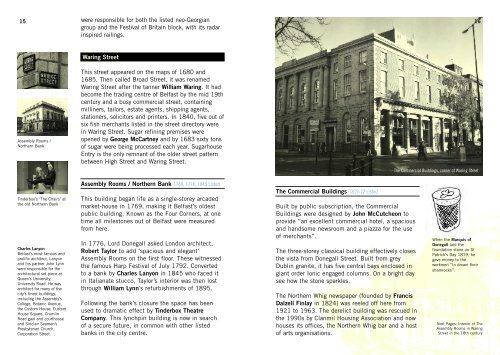Cathedral Quarter - Belfast City Council
Cathedral Quarter - Belfast City Council
Cathedral Quarter - Belfast City Council
You also want an ePaper? Increase the reach of your titles
YUMPU automatically turns print PDFs into web optimized ePapers that Google loves.
15<br />
Assembly Rooms /<br />
Northern Bank<br />
Tinderbox’s ‘The Chairs’ at<br />
the old Northern Bank<br />
Charles Lanyon<br />
<strong>Belfast</strong>’s most famous and<br />
prolific architect, Lanyon<br />
and his partner John Lynn<br />
were responsible for the<br />
architectural set piece at<br />
Queen’s University,<br />
University Road. He was<br />
architect for many of the<br />
city’s finest buildings,<br />
including the Assembly’s<br />
College, Botanic Avenue,<br />
the Custom House, Custom<br />
House Square, Crumlin<br />
Road gaol and courthouse<br />
and Sinclair Seamen’s<br />
Presbyterian Church,<br />
Corporation Street.<br />
were responsible for both the listed neo-Georgian<br />
group and the Festival of Britain block, with its radar<br />
inspired railings.<br />
Waring Street<br />
This street appeared on the maps of 1680 and<br />
1685. Then called Broad Street, it was renamed<br />
Waring Street after the tanner William Waring. It had<br />
become the trading centre of <strong>Belfast</strong> by the mid 19th<br />
century and a busy commercial street, containing<br />
milliners, tailors, estate agents, shipping agents,<br />
stationers, solicitors and printers. In 1840, five out of<br />
six fish merchants listed in the street directory were<br />
in Waring Street. Sugar refining premises were<br />
opened by George McCartney and by 1683 sixty tons<br />
of sugar were being processed each year. Sugarhouse<br />
Entry is the only remnant of the older street pattern<br />
between High Street and Waring Street.<br />
Assembly Rooms / Northern Bank 1769, 1776, 1845 Listed<br />
This building began life as a single-storey arcaded<br />
market-house in 1769, making it <strong>Belfast</strong>’s oldest<br />
public building. Known as the Four Corners, at one<br />
time all milestones out of <strong>Belfast</strong> were measured<br />
from here.<br />
In 1776, Lord Donegall asked London architect,<br />
Robert Taylor to add ‘spacious and elegant’<br />
Assembly Rooms on the first floor. These witnessed<br />
the famous Harp Festival of July 1792. Converted<br />
to a bank by Charles Lanyon in 1845 who faced it<br />
in Italianate stucco, Taylor’s interior was then lost<br />
through William Lynn’s refurbishments of 1895.<br />
Following the bank’s closure the space has been<br />
used to dramatic effect by Tinderbox Theatre<br />
Company. This lynchpin building is now in search<br />
of a secure future, in common with other listed<br />
banks in the city centre.<br />
The Commercial Buildings 1819-22 Listed<br />
Built by public subscription, the Commercial<br />
Buildings were designed by John McCutcheon to<br />
provide “an excellent commercial hotel, a spacious<br />
and handsome newsroom and a piazza for the use<br />
of merchants”.<br />
The three-storey classical building effectively closes<br />
the vista from Donegall Street. Built from grey<br />
Dublin granite, it has five central bays enclosed in<br />
giant order Ionic engaged columns. On a bright day<br />
see how the stone sparkles.<br />
The Northern Whig newspaper (founded by Francis<br />
Dalzell Finlay in 1824) was reeled off here from<br />
1921 to 1963. The derelict building was rescued in<br />
the 1990s by Clanmil Housing Association and now<br />
houses its offices, the Northern Whig bar and a host<br />
of arts organisations.<br />
16<br />
The Commercial Buildings, corner of Waring Street<br />
When the Marquis of<br />
Donegall laid the<br />
foundation stone on St<br />
Patrick’s Day 1819, he<br />
gave money to the<br />
workmen “to drown their<br />
shamrocks”.<br />
Next Pages: Interior of The<br />
Assembly Rooms in Waring<br />
Street in the 18th century





